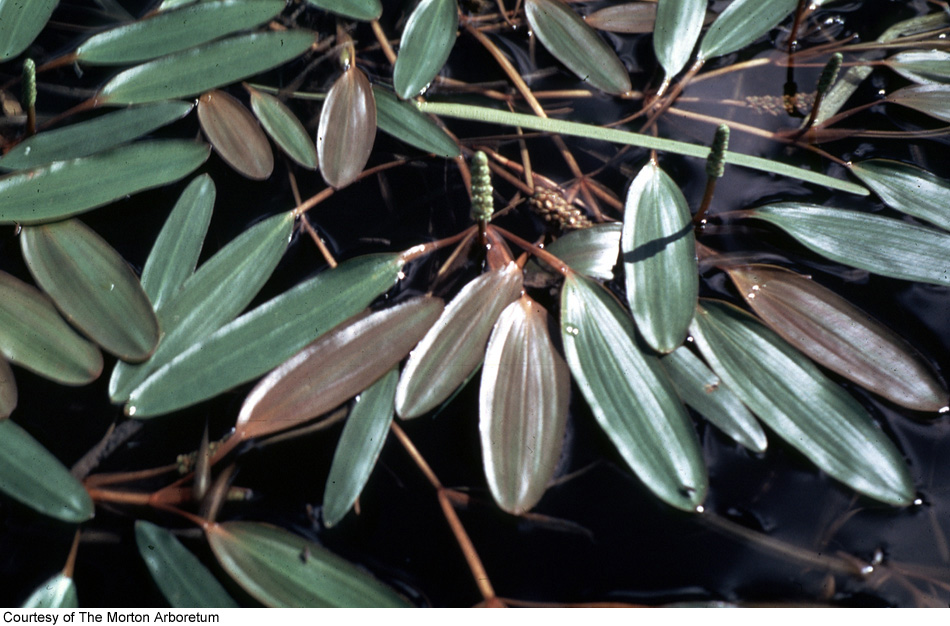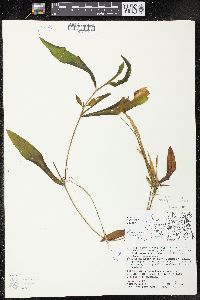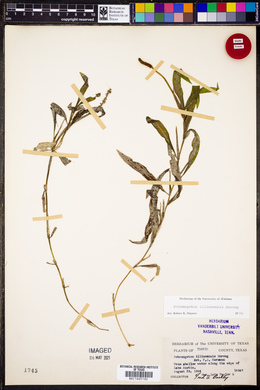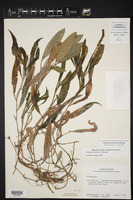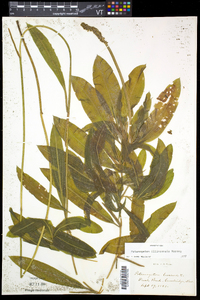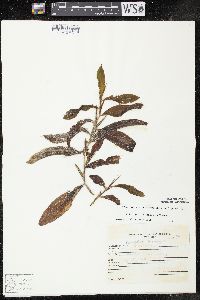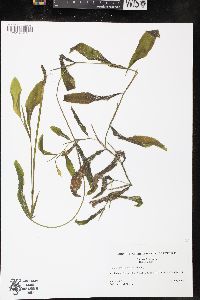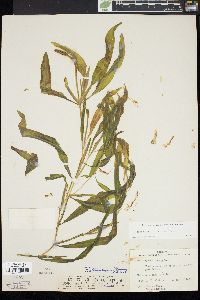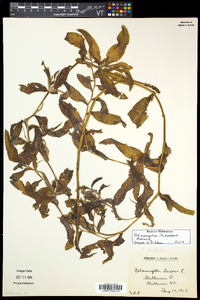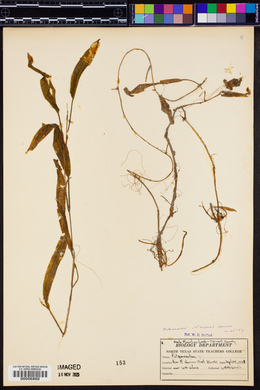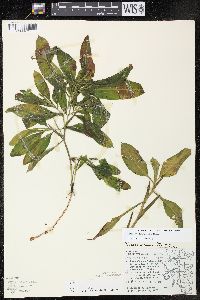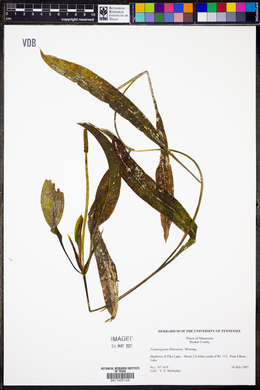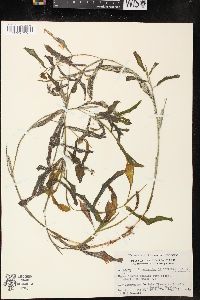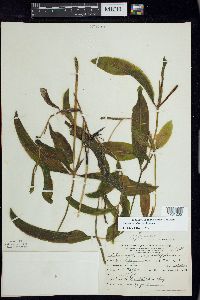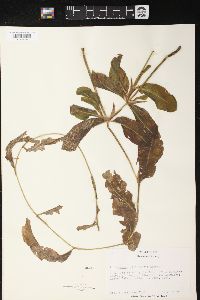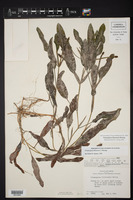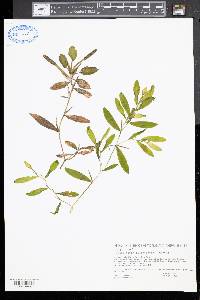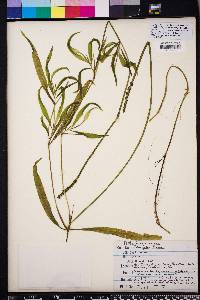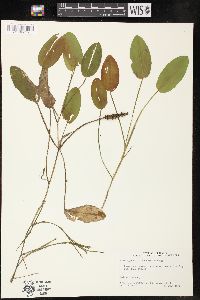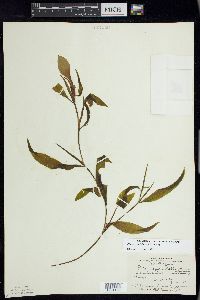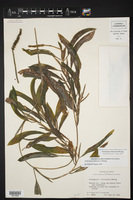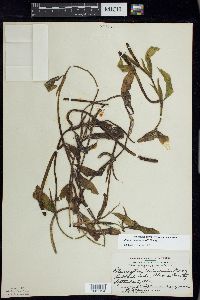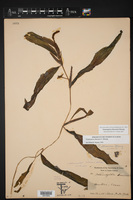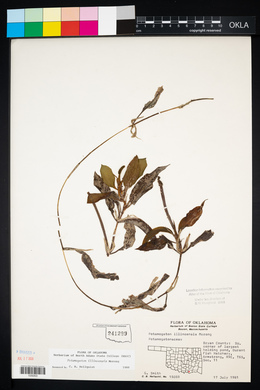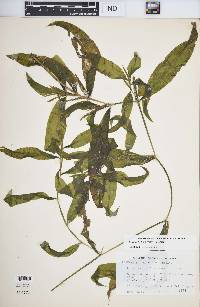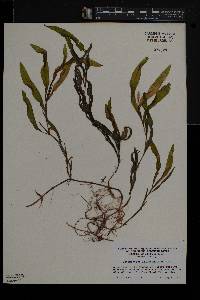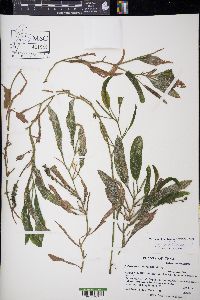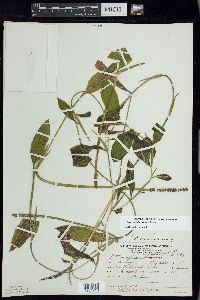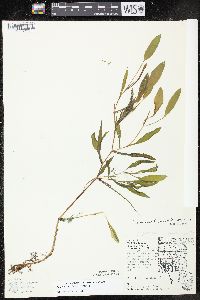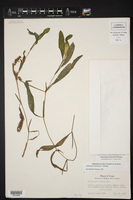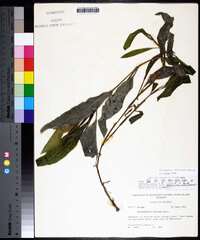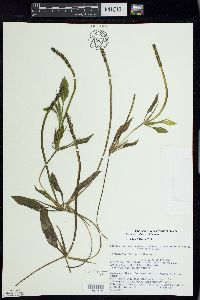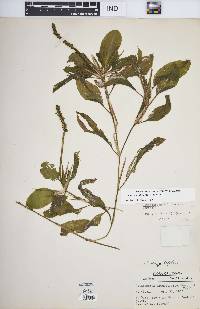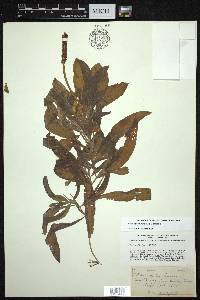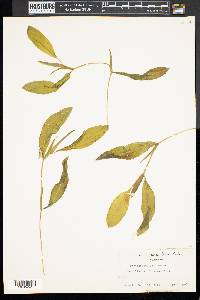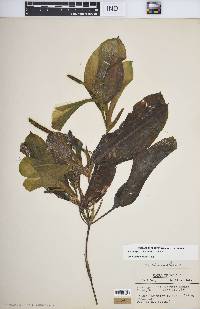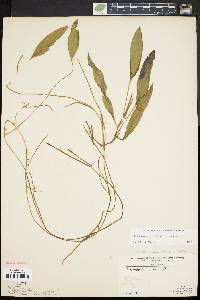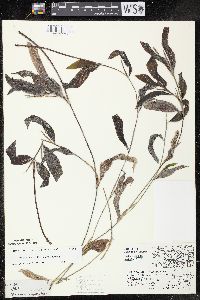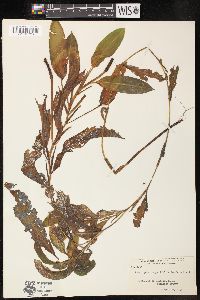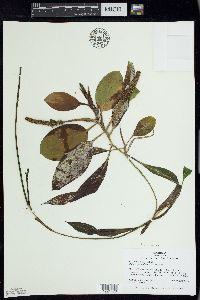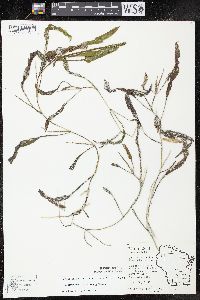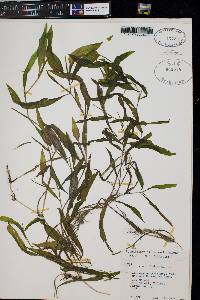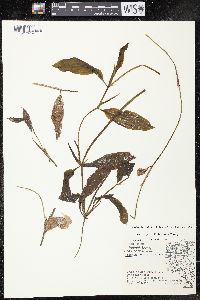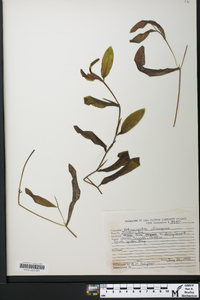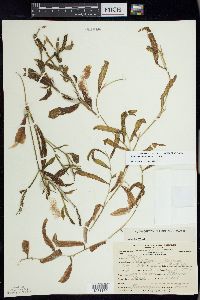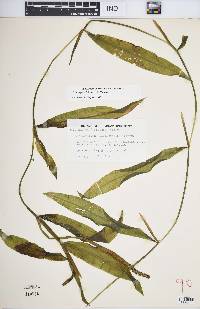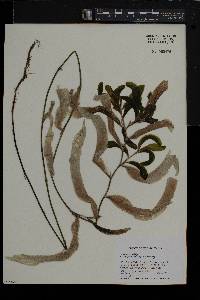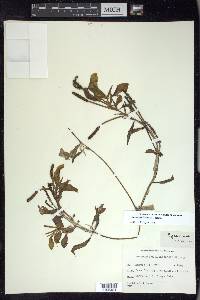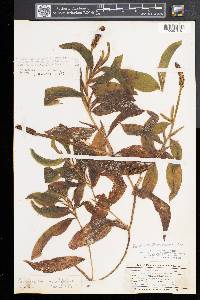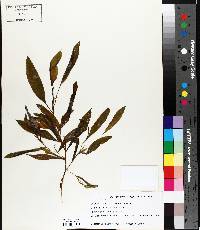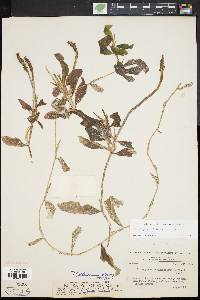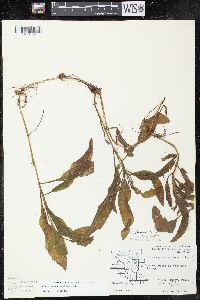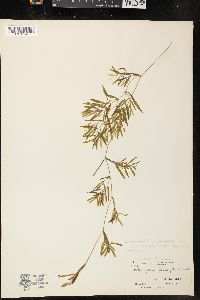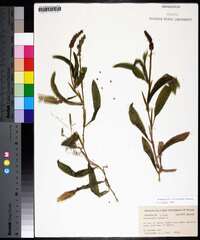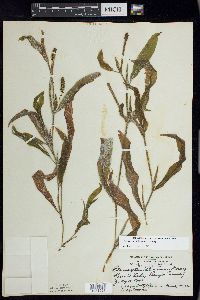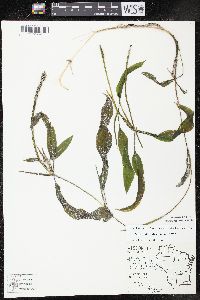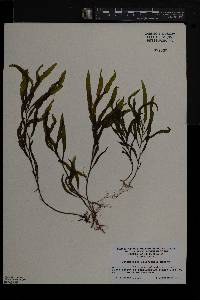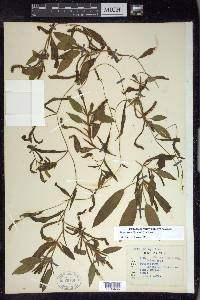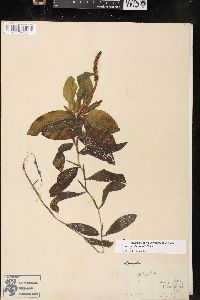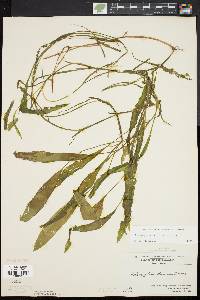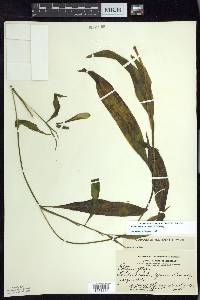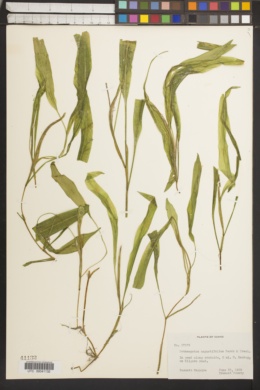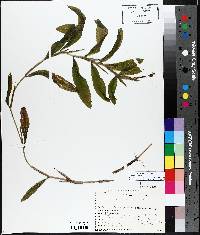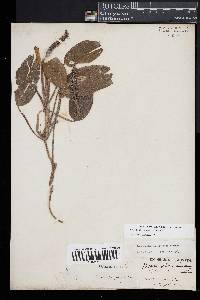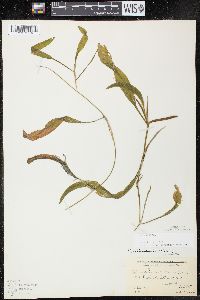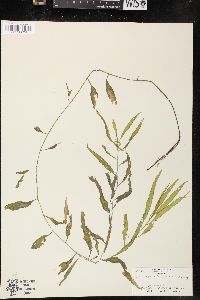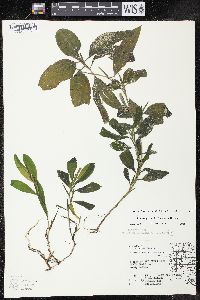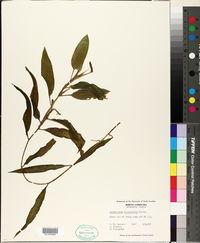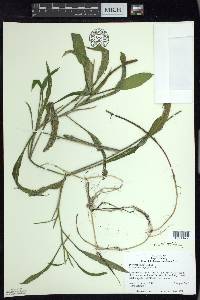Potamogeton illinoensis
|
|
|
|
Family: Potamogetonaceae
Illinois Pondweed, more...Methy Lake Pondweed
[Potamogeton angustifolius Bercht. & K. Presl, morePotamogeton fragillimus Hagstr., Potamogeton heterophyllus Schreb., Potamogeton lucens var. connecticutensis , Potamogeton lucens var. floridanus , Potamogeton methyensis A. Benn.] |
Rhizomes present. Cauline stems terete, without spots, 28--120 cm; nodal glands absent. Turions absent. Leaves both submersed and floating or the floating absent, ± spirally arranged. Submersed leaves sessile or petiolate, lax; stipules persistent, conspicuous, convolute, free from blade, light brown to red-brown, not ligulate, 1--8 cm, not fibrous, not shredding at tip, apex acuminate; petioles if present 0.5--4 cm; blade red-brown to light green, elliptic to lanceolate or rarely linear, often arcuate, 5--20 cm ´ 2--45 mm, base acute, margins entire, often crispate, apex not hoodlike, acute-mucronate, lacunae in 2--5 rows each side midrib; veins 7--19. Floating leaves: petioles continuous in color to apex, 2--9 cm; blade adaxially light green, elliptic to oblong-elliptic, 4--19 cm ´ 20--65 mm, base cuneate, apex round-mucronate; veins 13--29. Inflorescences emersed, unbranched; peduncles not dimorphic, terminal or axillary, erect to ascending, cylindric, 4--30 cm; spikes not dimorphic, cylindric, 25--70 mm. Fruits sessile, grayish green to olive green, obovoid to ovoid, laterally compressed, abaxially keeled, laterally ridged, 2.5--3.6 ´ 2.1--3 mm, abaxial keel well developed, lateral ridges without points; beak erect to slightly recurved, 0.5--0.8 mm; sides without basal tubercles; embryo with 1 full spiral. 2n = 104. Flowering and fruiting summer--fall. Alkaline waters of streams, rivers, lakes, ponds, and sloughs; 0--2700 m; B.C., Man., N.B., N.W.T., Ont., Que.; Ala., Ark., Calif., Colo., Conn., Fla., Ga., Ill., Ind., Iowa, Kans., Ky., Md., Mass., Mich., Minn., Mo., Mont., Nebr., N.H., N.J., N.Y., N.C., Okla., Ohio, Oreg., Pa., S.C., S.Dak., Tex., Utah, Vt., Va., Wash., W.Va., Wis., Wyo.; Mexico; West Indies; Central America; South America. Potamogeton illinoensis and P. gramineus are often difficult to separate. Certainly, in the extreme of each they are easily separated, but they continually grade into each other. Features to look for are the acute-mucronate apex of the submersed leaves of P. illinoensis and the acuminate apex for P. gramineus. Also, the number of veins seems to work as well. Three hybrids, Potamogeton illinoensis ´ P. nodosus (= P. ´ faxonii Morong), P. amplifolius ´ P. illinoensis (= P. ´ scoliophyllus Hagström), and P. gramineus ´ P. illinoensis [= P. ´ spathuliformis (J. W. Robbins) Morong], have been described.
Perennial submersed aquatic herb with rhizomes 28 cm - 1.2 m tall Stem: stout, much-branched, jointed. Inflorescence: an upright, dense, cylindrical spike of flowers, emersed, unbranched, 2.5 - 7 cm long, on a terminal or axillary stalk. Stalk cylindrical, 4 - 30 cm long, often thicker than stem. Flowers: greenish, tiny. Stamens four. Anthers two-chambered, with four edge-to-edge sepal-like outgrowths. Fruit: an achene, stalkless, olive green to grayish green, 2.5 - 4 mm long (including the upright to slightly recurved, 0.5 mm long beak), 2 - 3 mm wide, egg-shaped to reverse egg-shaped, laterally compressed, with three conspicuous keels. Submersed leaves: more or less arranged spirally, stalkless or short-stalked (to 4 cm), translucent, light green to reddish brown, 5 - 20 cm long, 2 - 5 cm wide, lance-shaped to elliptic with a tapering base and pointed tip, often arching, seven- to nineteen-veined. Stipules axillary, conspicuous, free from leaf blade, brown to reddish brown, rolled up, 1 - 10 cm long. Floating leaves: (if present) more or less arranged spirally, on a 2 - 9 cm long stalk, 4 - 19 cm long, 2 - 6.5 cm wide, lance-shaped to elliptic to oblong elliptic with a tapering base and a rounded tip (tip bears a short, abrupt point), 13- to 29-veined, leathery, firmer than submersed leaves. Similar species: Potamogeton gramineus is often similar but can be distinguished by its fewer number of veins on the floating leaves. Also, the tips of the submersed leaves sometimes exhibit a short, tiny point, which P. illinoensis does not. Flowering: mid-July to mid-September Habitat and ecology: Occasional in lakes, often in calcareous waters. Occurence in the Chicago region: native Notes: Plants in the genus Potamogeton are very important to wildlife, offering habitat and food for many aquatic animals. Etymology: Potamogeton comes from the Greek words potamos, meaning river, and geiton, meaning neighbor, referring to the habitat of these plants. Illinoensis means "of or from Illinois." Author: The Morton Arboretum Stem stout, usually much branched, to 2 m; submersed lvs lanceolate to oblanceolate or narrowly obovate, 8-20 נ2-5 cm, 9-19-nerved, acute, tapering to a sessile or short-petioled base; floating lvs not always developed, lanceolate to elliptic, 7-13 נ2-6 cm, the stout petiole 4-11 cm; stipules axillary, free, obtuse, 4-10 cm; peduncles 4-12 cm, usually thicker than the stem, but not clavate; spikes dense, cylindric, 2.5-6 cm; frs broadly semi-obovoid, 3-4 mm (including the 0.5 mm beak), with 3 conspicuous but low dorsal keels; 2n=104. In quiet water; N.S. to Ont., Minn., and Calif., s. to Fla. and Mex. (P. angustifolius; P. lucens, misapplied) Gleason, Henry A. & Cronquist, Arthur J. 1991. Manual of vascular plants of northeastern United States and adjacent Canada. lxxv + 910 pp. ©The New York Botanical Garden. All rights reserved. Used by permission. From Flora of Indiana (1940) by Charles C. Deam Infrequent in the lakes throughout the lake area. …… Indiana Coefficient of Conservatism: C = 7 Wetland Indicator Status: OBL |

